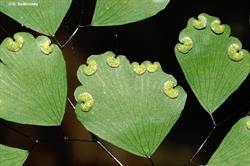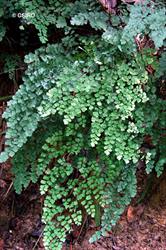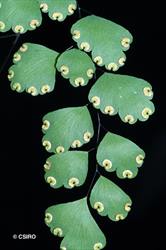Pteridaceae
Australian Tropical Ferns and Lycophytes - Online edition
Adiantum atroviride



Adiantum atroviride Bostock
Link to Australian Plant Name Index for publication details and synonyms: https://id.biodiversity.org.au/name/apni/154087
Maidenhair Fern
Rhizome ±erect or short- to very short-creeping, to 5 mm diam., stoloniferous or (in NT and Cape York Peninsula) stolons lacking; scales triangular, dark brown, ±opaque, with shortly ciliate margins and prominent apical seta, or (in Cape York Peninsula) occasionally yellow, ±translucent, with entire margins and acuminate apex, in both forms sometimes contorted but not spirally curled. Fronds erect to arching, to 75 cm long, usually loosely clustered, or (in Cape York Peninsula) markedly tufted. Stipe and rachises bearing few to many ephemeral 2-celled glandular hairs which secrete a pale yellow farina during frond enlargement. Stipe to 34 cm long, glossy, dark brown or purple-brown to black when mature and (in Cape York Peninsula) of milky appearance at maturity due to remains of glandular hairs. Rachises similar in colour and glossiness. Lamina 2–4-pinnate, ovate to narrowly triangular, 12–42 cm long, 8–30 cm wide. Pinnae ovate to triangular. Pinnules flabellate, rarely round; distal margins shallowly lobed; lobe margins denticulate when sterile, otherwise entire; small whitish nodosity usually present on rachis at junction with pinnule stalk; stalks not articulated. Sori 1–7 along distal margins, 1 or 2 per lobe; soral flaps round to reniform, usually at base of a deep often narrow sinus on pinnule margin. Spores 64 per sporangium, with largest diam. (27.6–) 40.3 (–54.7) µm.
Northern and eastern
Terrestrial in the understorey of xeric to mesic vine forest or sclerophyll forest in a wide variety of geologies and vegetation communities.
This is a commonly cultivated ornamental fern in tropical, subtropical and temperate areas. It is suited to cultivation in a semi-shaded to shaded part of the garden or in a greenhouse. It is suited to cultivation in the ground or in a container planted in a free-draining terrestrial growing medium. A tidy plant can be produced by removal of old fronds once per year just prior to the emergence of new fronds in spring. New plants are produced by spores or by division. Cape York forms are usually deciduous in the winter dry season.
Key to some Adiantum species of tropical
1a. Fronds pinnate = Adiantum philippense
1b. Fronds bipinnate or higher = 2
2a. Pinnules flabellate to rounded = 3
2b. Pinnules obliquely oblong to rhomboid = 5
3a. Soral flaps broadly attached to lamina and situated on the ends of lobes with incisions between them = Adiantum capillus-veneris
3b. Soral flaps reniform and narrowly attached to lamina and situated in incisions of the lamina margin with lobes between them = 4
4a. Rhizome long creeping, rhizome scales translucent with entire margins, plants stoloniferous and spreading, pinnae pale bright green when mature = Adiantum aethiopicum
4b. Rhizome short creeping, rhizome scales opaque with denitculate margins, not stoloniferous plants tufted, pinnae dark green when mature = Adiantum atroviride
5a. Rhizome long creeping, fronds scattered = 6
5b. Rhizome not long creeping, fronds tufted = 7
6a. Primary pinnae progressively reducing in length from base to apex of frond resulting in a triangular lamina = Adiantum formosum
6b. Primary pinnae equal in length resulting in an ovate lamina = Adiantum silvaticum
7a. Pinnae soft and membraneous with fine black hairs on the undersurface, root tubers present, often proliferous, stipe smooth = Adiantum diaphanum
7b. Pinnae herbaceous to coreaceous with white hairs, root tubers absent, not proliferous, stipe not smooth = Adiantum hispidulum
Field AR, Quinn CJ, Zich FA (2022) Australian Tropical Ferns and Lycophytes. apps.lucidcentral.org/fern/text/intro/index.htm (accessed online INSERT DATE).
Field AR, Quinn CJ, Zich FA (2022) ‘Platycerium superbum’, in Australian Tropical Ferns and Lycophytes. apps.lucidcentral.org/fern/text/entities/platycerium_superbum.htm (accessed online INSERT DATE).







